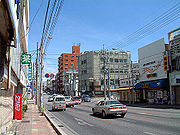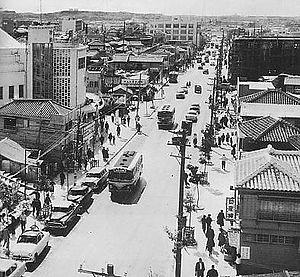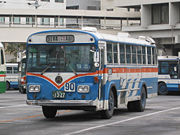
730 (transport)
Encyclopedia




Okinawa Prefecture
is one of Japan's southern prefectures. It consists of hundreds of the Ryukyu Islands in a chain over long, which extends southwest from Kyūshū to Taiwan. Okinawa's capital, Naha, is located in the southern part of Okinawa Island...
of Japan switched back from driving on the right-hand side of the road to the left.
Overview
Originally, Okinawa drove on the left-hand side of the road, the same as the rest of Japan. However, after the defeat of Japan during World War IIWorld War II
World War II, or the Second World War , was a global conflict lasting from 1939 to 1945, involving most of the world's nations—including all of the great powers—eventually forming two opposing military alliances: the Allies and the Axis...
, the prefecture went under control of the United States and was made to drive on the right on June 24, 1945. Even after Okinawa was returned to Japanese control in 1972, it still had its traffic driving on the right for six years due to delays in the handover to Japan and delays to the Expo '75
Expo '75
Expo '75 was a World's Fair held on the island of Okinawa in Japan from July 20, 1975 to January 18, 1976.-History :...
. However, in accordance with the Vienna Convention on Road Traffic
Vienna Convention on Road Traffic
The Vienna Convention on Road Traffic is an international treaty designed to facilitate international road traffic and to increase road safety by standardising the uniform traffic rules among the contracting parties...
that restricts one country to have only one traffic direction, all the traffic in the prefecture was changed back to driving on the left on July 30, 1978. It is one of very few places to have changed from right- to left- traffic in the late twentieth century. The day symbolized Okinawa's return to Japan.
Changing the direction
All traffic was banned from 22:00 July 29, 1978. Eight hours after, at 06:00 July 30, traffic was resumed, changed on the left-hand side. Traffic signTraffic sign
Traffic signs or road signs are signs erected at the side of roads to provide information to road users. With traffic volumes increasing over the last eight decades, many countries have adopted pictorial signs or otherwise simplified and standardized their signs to facilitate international travel...
s were changed within these eight hours.
As there were not enough police officers in Okinawa Prefecture to control all the traffic for the day, police officers were gathered from other parts of Japan.
Most left-hand side signs and signals had already been installed before the day but covered. During the eight hours transition the covers were removed and transferred to the old right-hand side signs. The scheme was called the , after , Okinawa Prefectural police officer in charge of 730, who "invented" the scheme.
The prefecture publicized the change beforehand through the , including posters and TV advertisements. The TV advertisement featured Yōkō Gushiken
Yoko Gushiken
was a Ryukyuan professional boxer from 1974-1981. His professional record is 23-1 and he held the title of WBA Light Flyweight champion 1976-1981.-Biography:...
, a famous boxer from the prefecture.
In the prefecture, from the late 1970s until early 1980s, right-hand drive vehicles were often called , while LHD vehicles were called . Both expressions are now obsolete. Although rare, there are still a few "729 cars" surviving on the road.
The Japanese government spent some $150 million to cover the prefecture's conversion costs, which included relocating bus stops, moving signs, replacing 1,000 buses and 5,000 taxis, as well as replacing headlights on 300,000 vehicles so that they aimed to the left instead of the right. The United States military spent nearly $500,000 to switch signs on its bases.
Bus
Local busBus
A bus is a road vehicle designed to carry passengers. Buses can have a capacity as high as 300 passengers. The most common type of bus is the single-decker bus, with larger loads carried by double-decker buses and articulated buses, and smaller loads carried by midibuses and minibuses; coaches are...
companies had to change passenger doors on the right-hand side of the vehicle to the left. The bus operators in the prefecture, namely Ryūkyū Bus (the present Ryūkyū Bus Kōtsū), Okinawa Bus, Naha Kōtsū (the present Naha Kōtsū Bus), and Tōyō Bus introduced more than 1000 buses in total, with subsidies from the prefecture and the national government. These particular buses are sometimes called ,
Many LHD buses were introduced at the time of Expo '75
Expo '75
Expo '75 was a World's Fair held on the island of Okinawa in Japan from July 20, 1975 to January 18, 1976.-History :...
, held before the 730. As these cars were relatively new, some of them were modified to RHD with left-hand side doors. Some others were sold to right-hand side driving countries such as China.
Many 730 buses survived until 2000s. However, most of them retired after 2004. As of 2008, both Okinawa Bus and Tōyō Bus each still preserve one, but neither operates them regularly.
Aftermath
There were many traffic accidents right after the 730. When turning right/left on a crossing, drivers often approached to the right-hand side of the road, although they had to approach to the left. This led to many collisions on a crossing. Larger accidents included a frontal collision of two buses.Memorial
In IshigakiIshigaki, Okinawa
Ishigaki is an island west of Okinawa Hontō and the second-largest island of the Yaeyama Island group. It is within the City of Ishigaki in Okinawa Prefecture. The city functions as the business and transport center of the archipelago...
, there is the with a 1m tall memorial stone. In Miyakojima
Miyakojima, Okinawa
is a city on several islands in Okinawa Prefecture, Japan. It was formed on October 1, 2005 by the merger of the old city of Hirara, the towns of Gusukube, Irabu and Shimoji, and the village of Ueno, all from Miyako District, which as a result of the merger has one remaining village.Miyakojima has...
, there is the .
See also
- Right- and left-hand traffic
- Dagen HDagen HDagen H , today mostly called "Högertrafikomläggningen" , was the day, 3 September 1967, on which traffic in Sweden switched from driving on the left-hand side of the road to the right...
Switch to right hand traffic in Sweden - Switch to right hand traffic in CzechoslovakiaSwitch to right hand traffic in CzechoslovakiaThe switch to right hand traffic in Czechoslovakia describes changes in the rules of the road in 1938/1939.Before 1938, Czechoslovakia drove on the left. In about 1925, Czechoslovakia accepted the Paris convention and undertook to change to right hand traffic "within a reasonable time frame". In...
External links
やんばる国道物語 (Yanbaru National Highway stories), Northern National Highway Office of Okinawa General Bureau, Cabinet OfficeCabinet Office (Japan)
is an agency in the Cabinet of Japan. It is responsible for handling the day to day affairs of the cabinet. The Cabinet Office is formally headed by the Prime Minister. There are usually three Vice Ministers and three Parliamentary Secretaries in the Cabinet Office.-Organization:-External...
. 手づくり石けんのウェッブショップ うみきぃ・うみない (Handmade soap webshop Umikii-Uminai), a personal blog with many 730 pictures.

